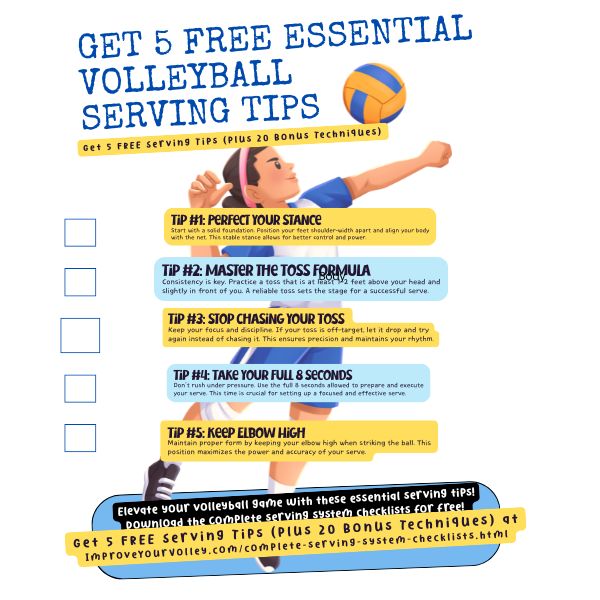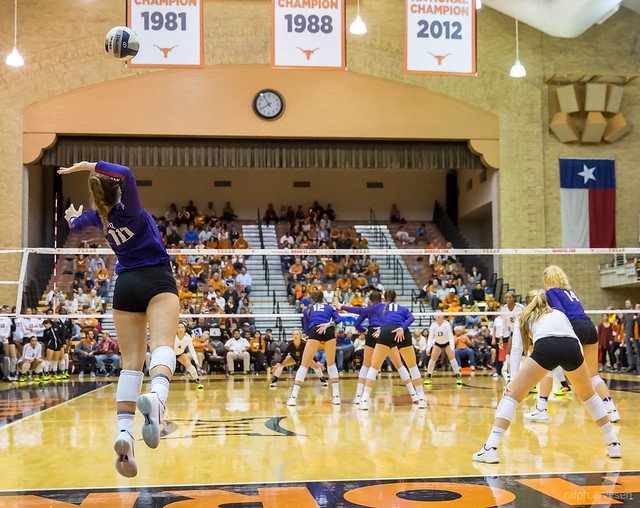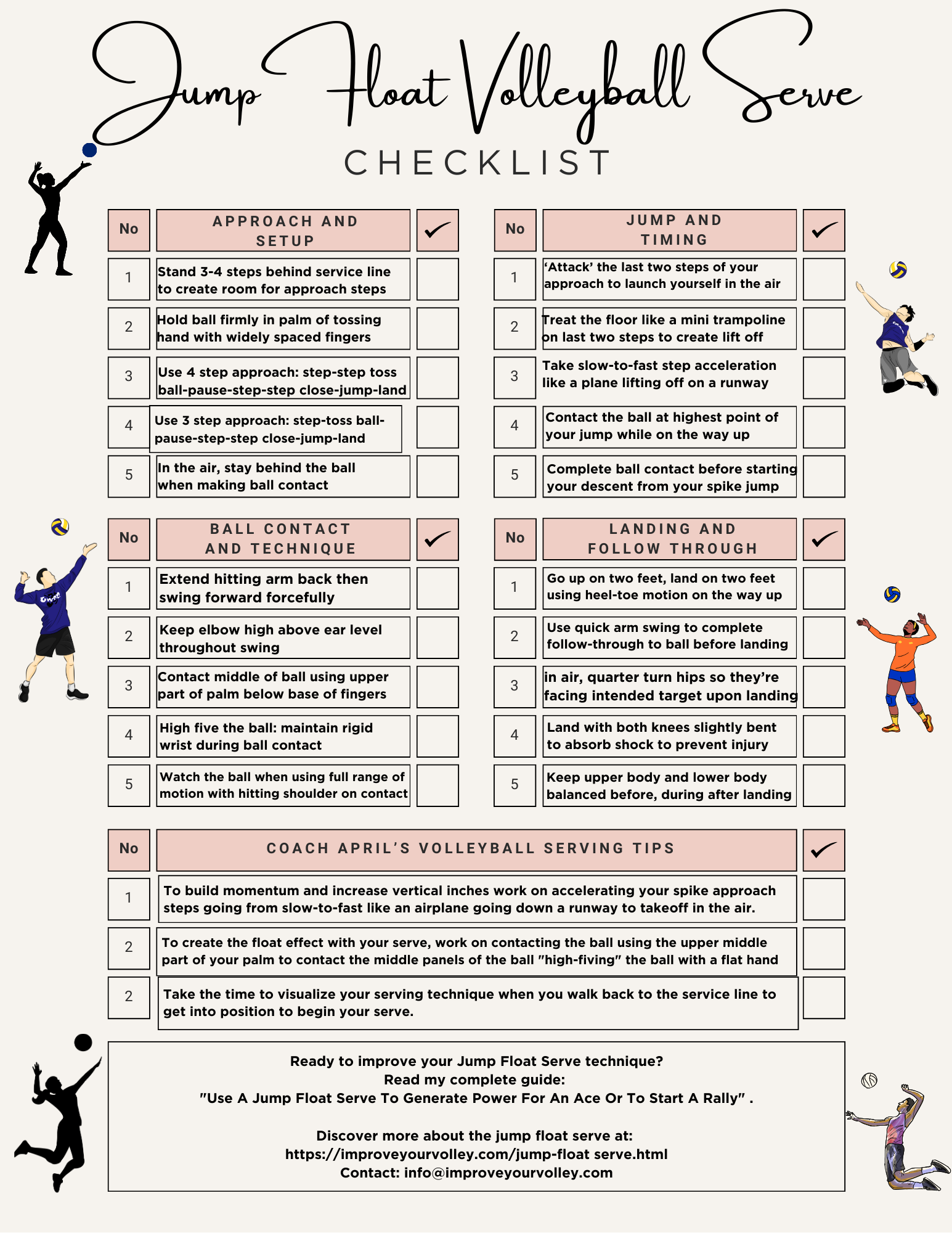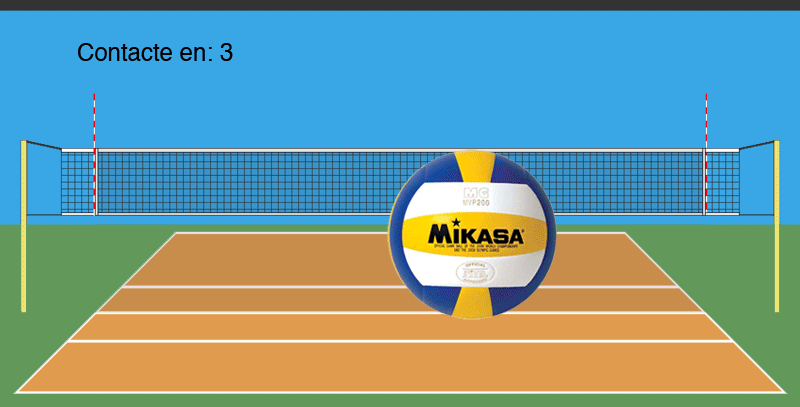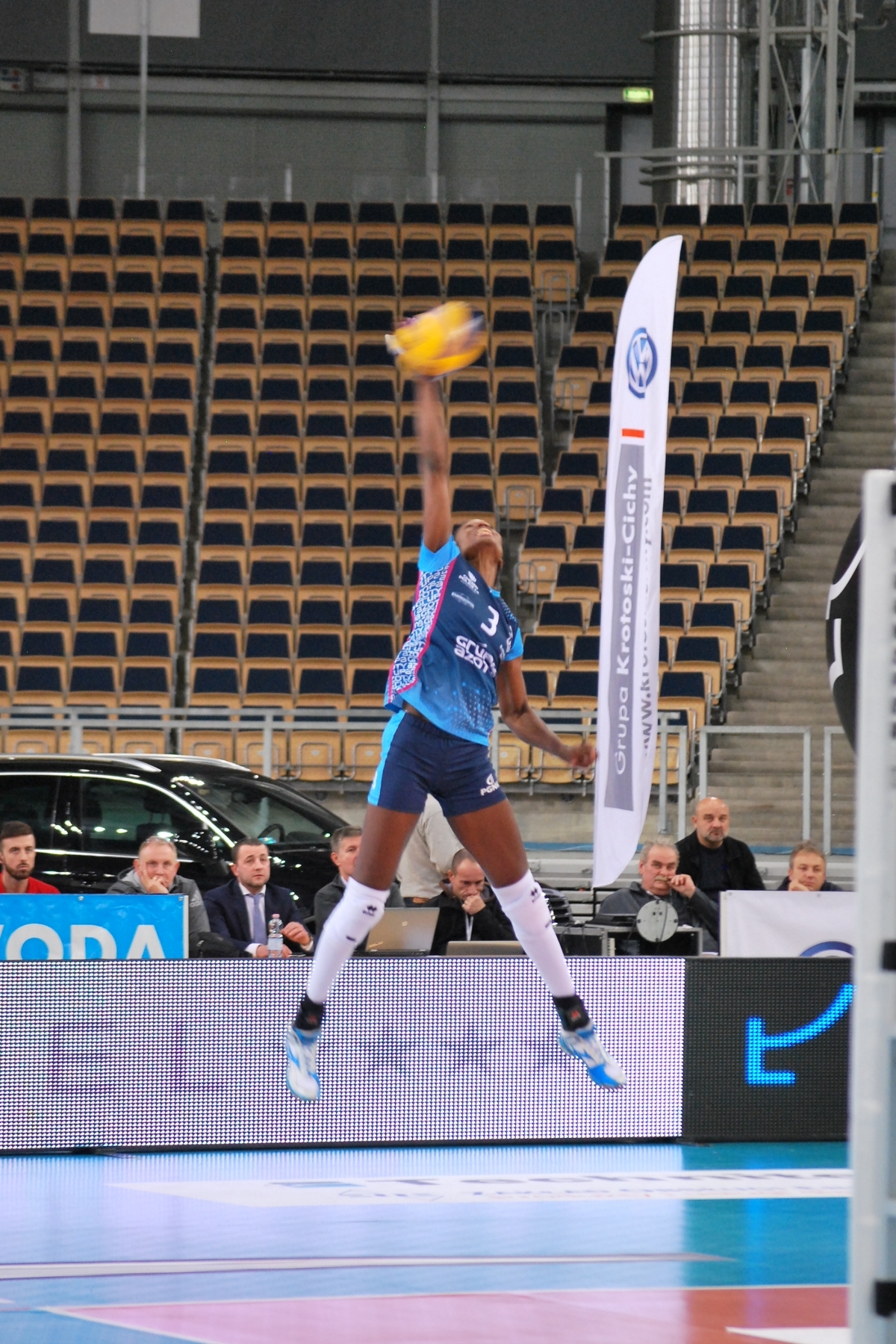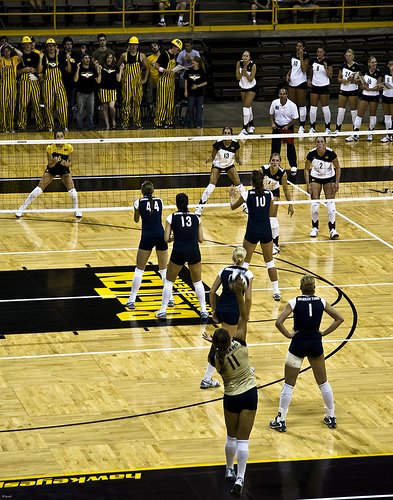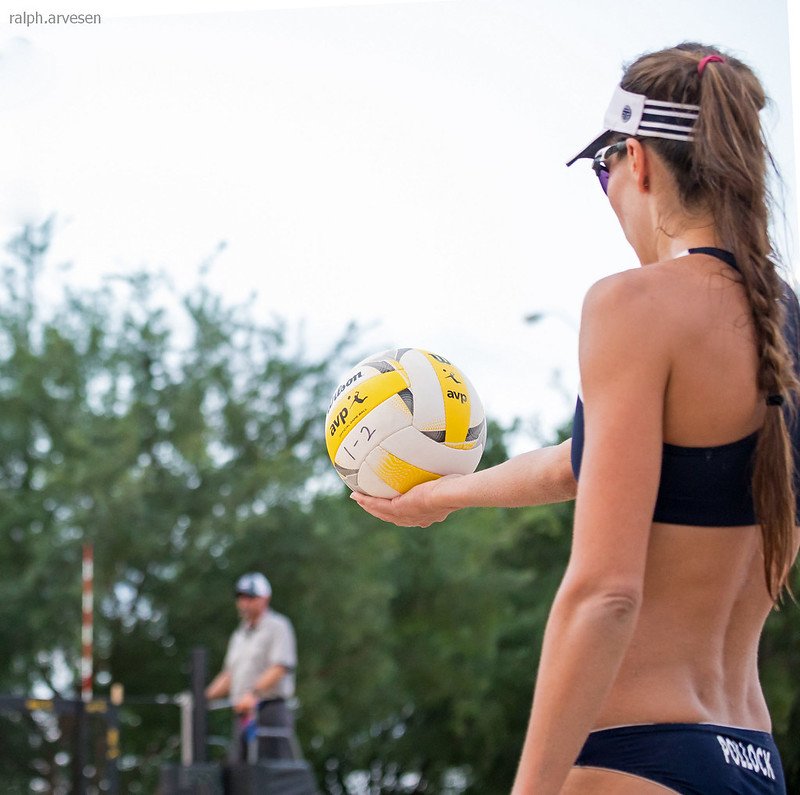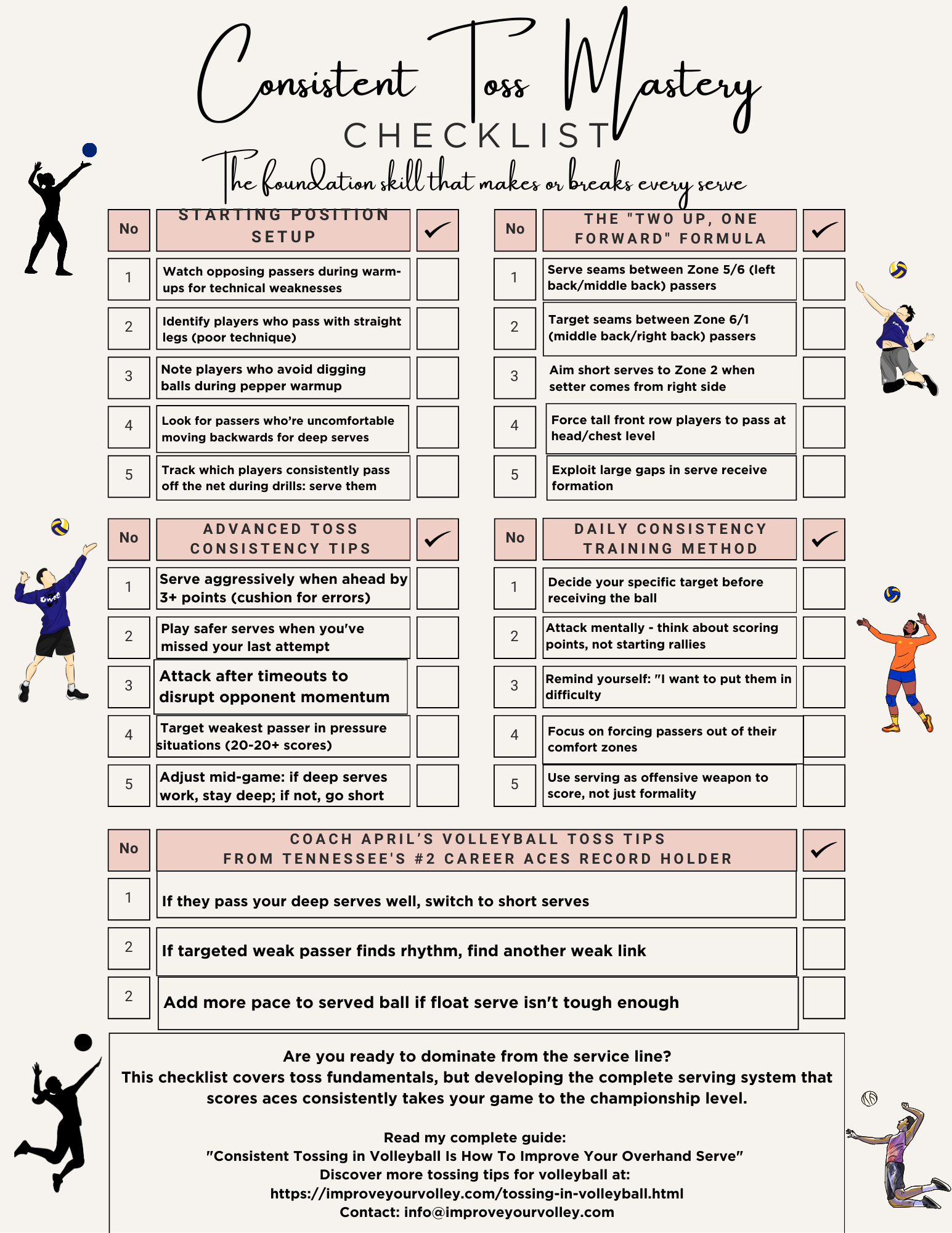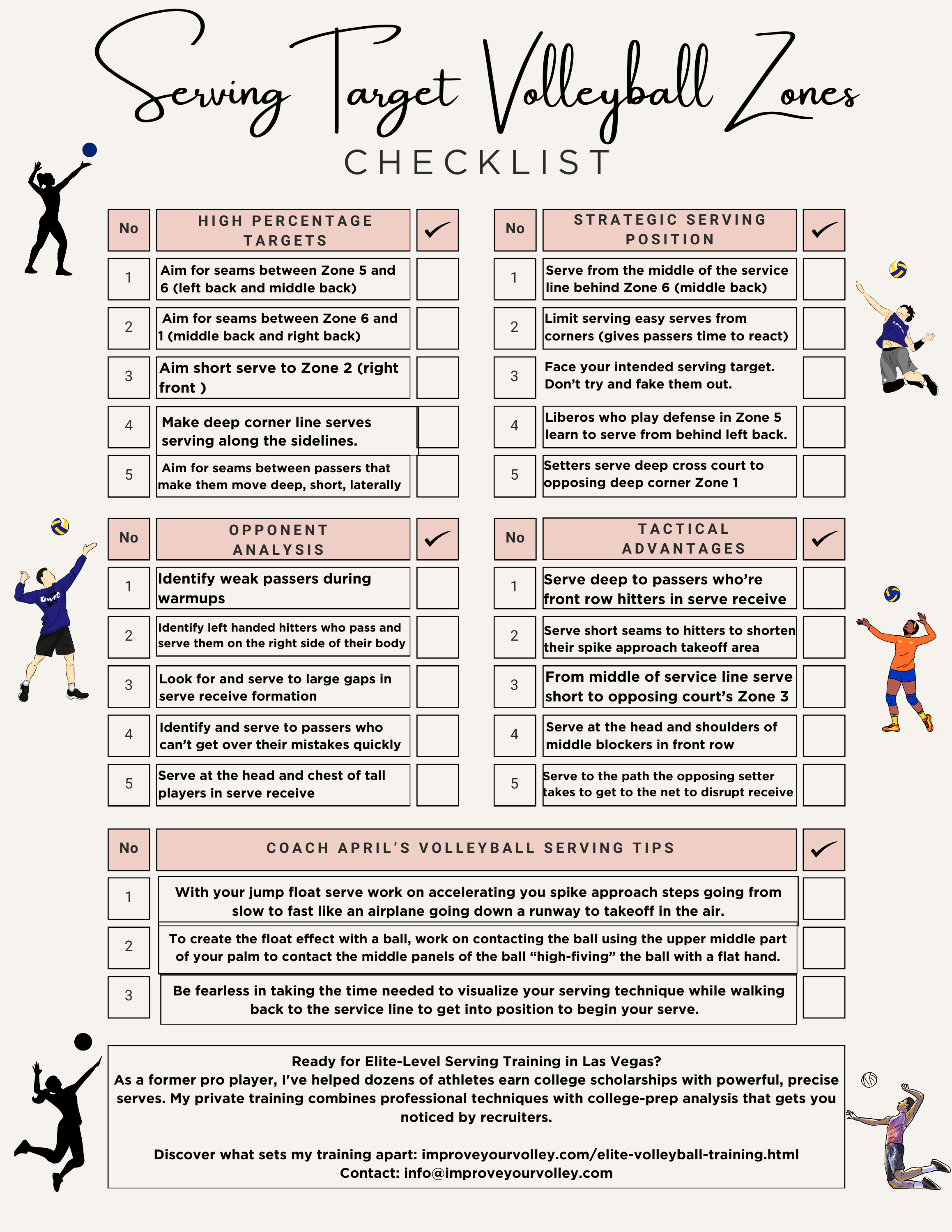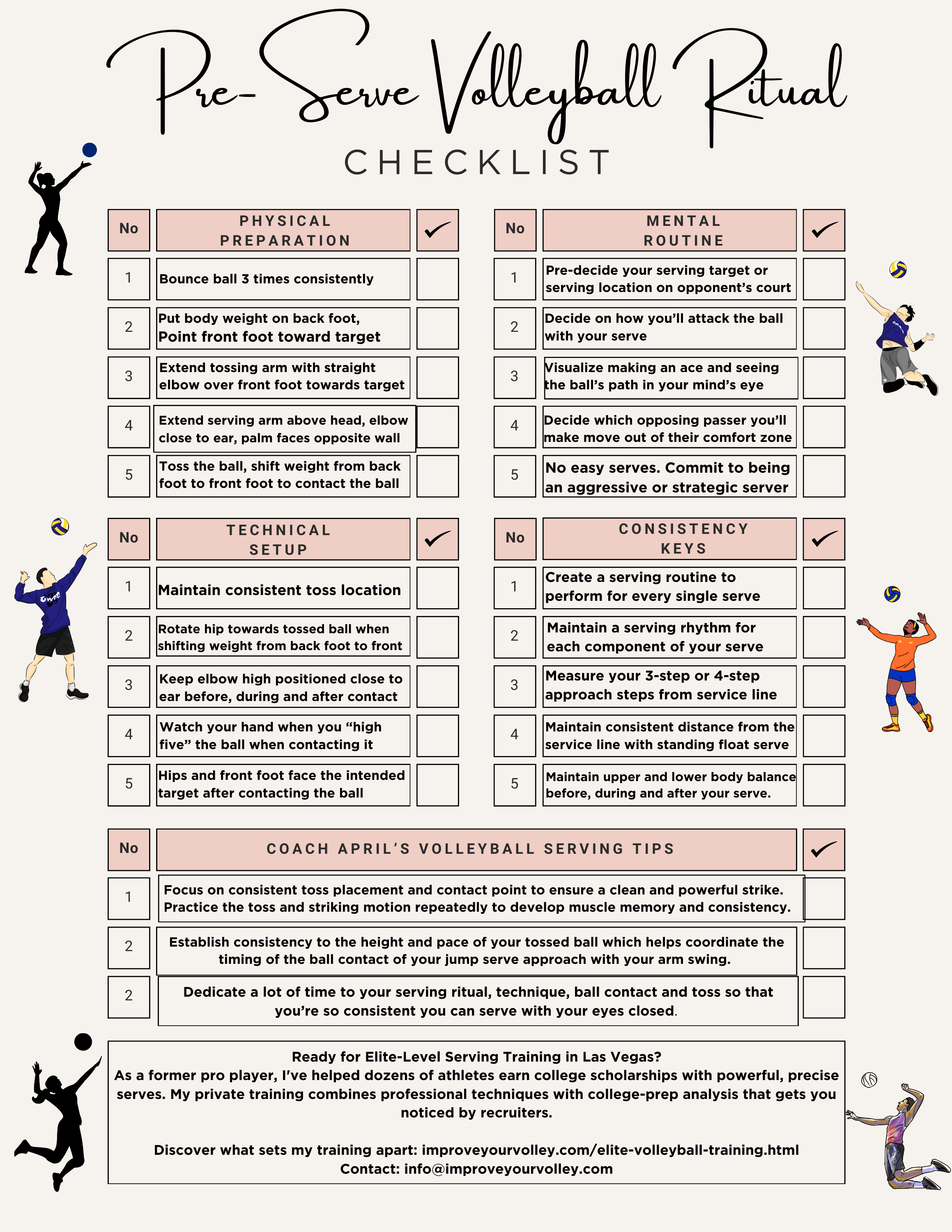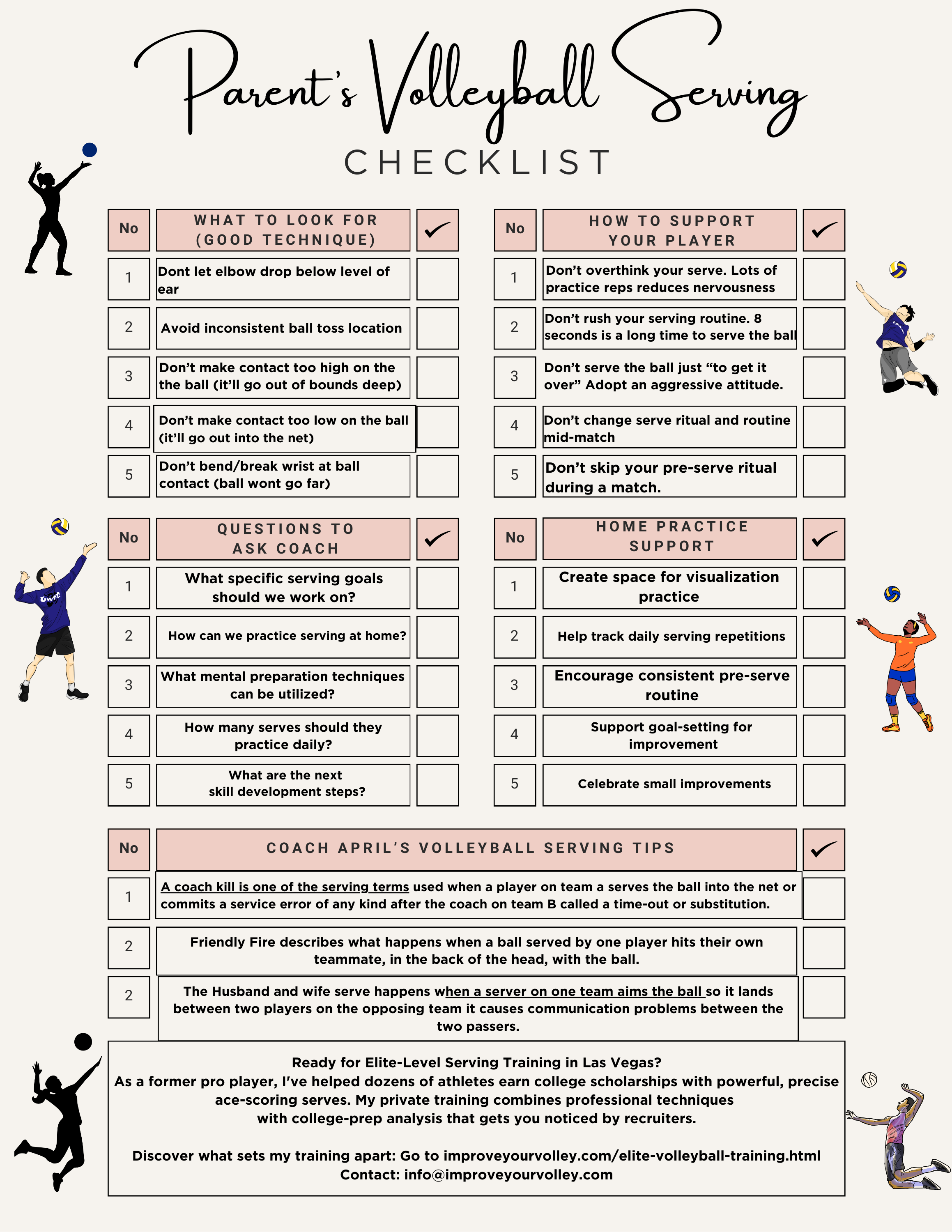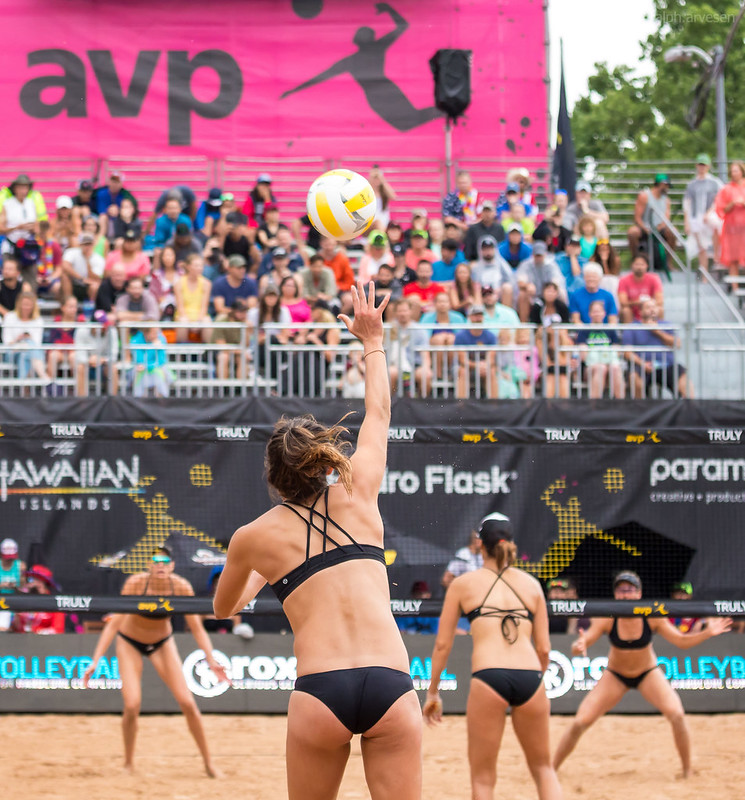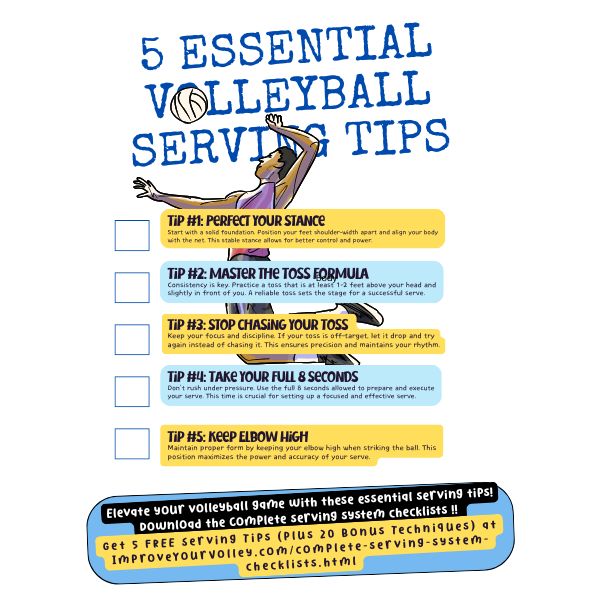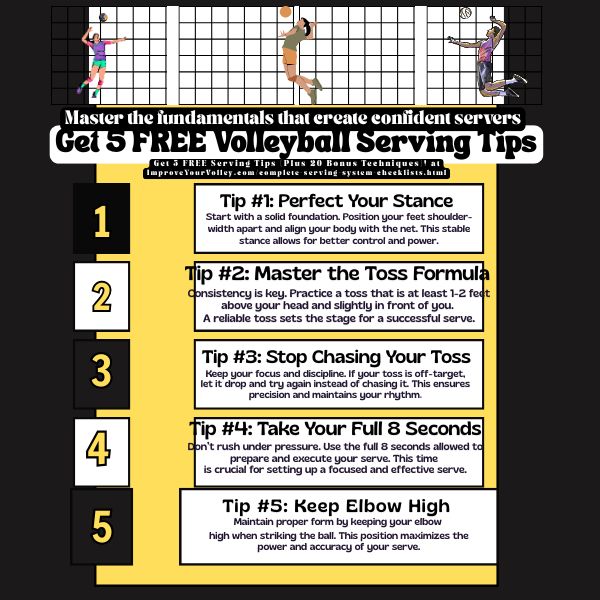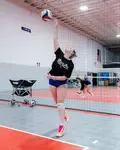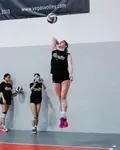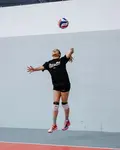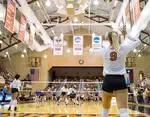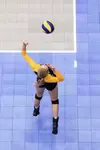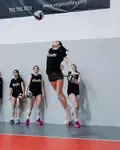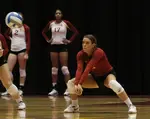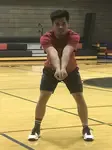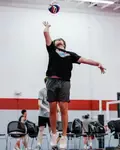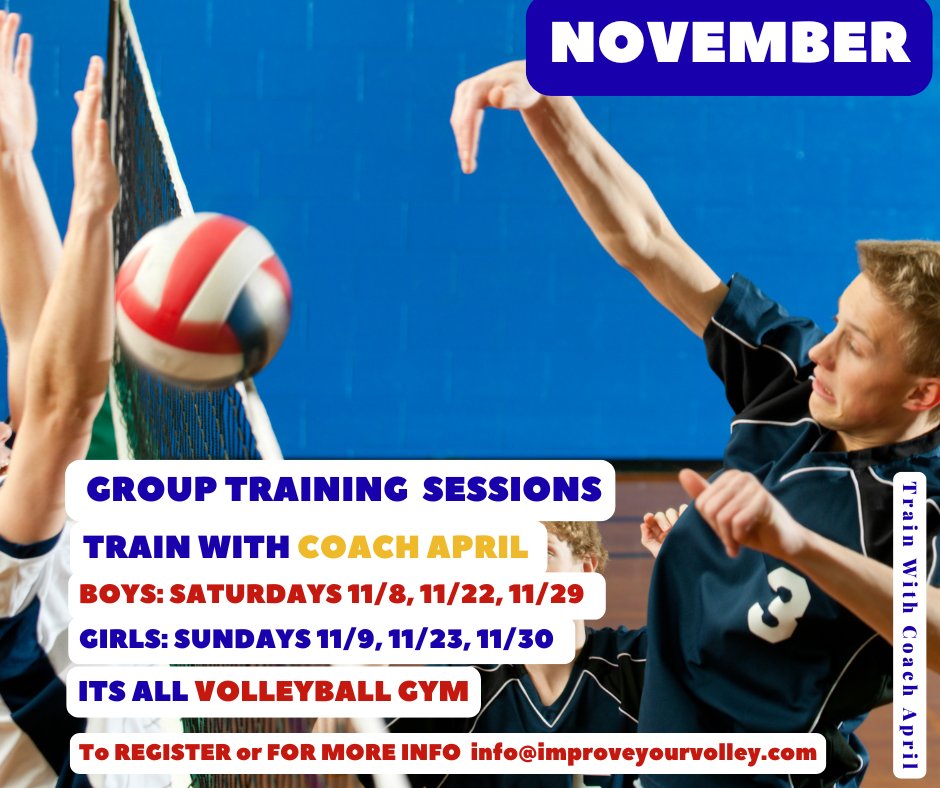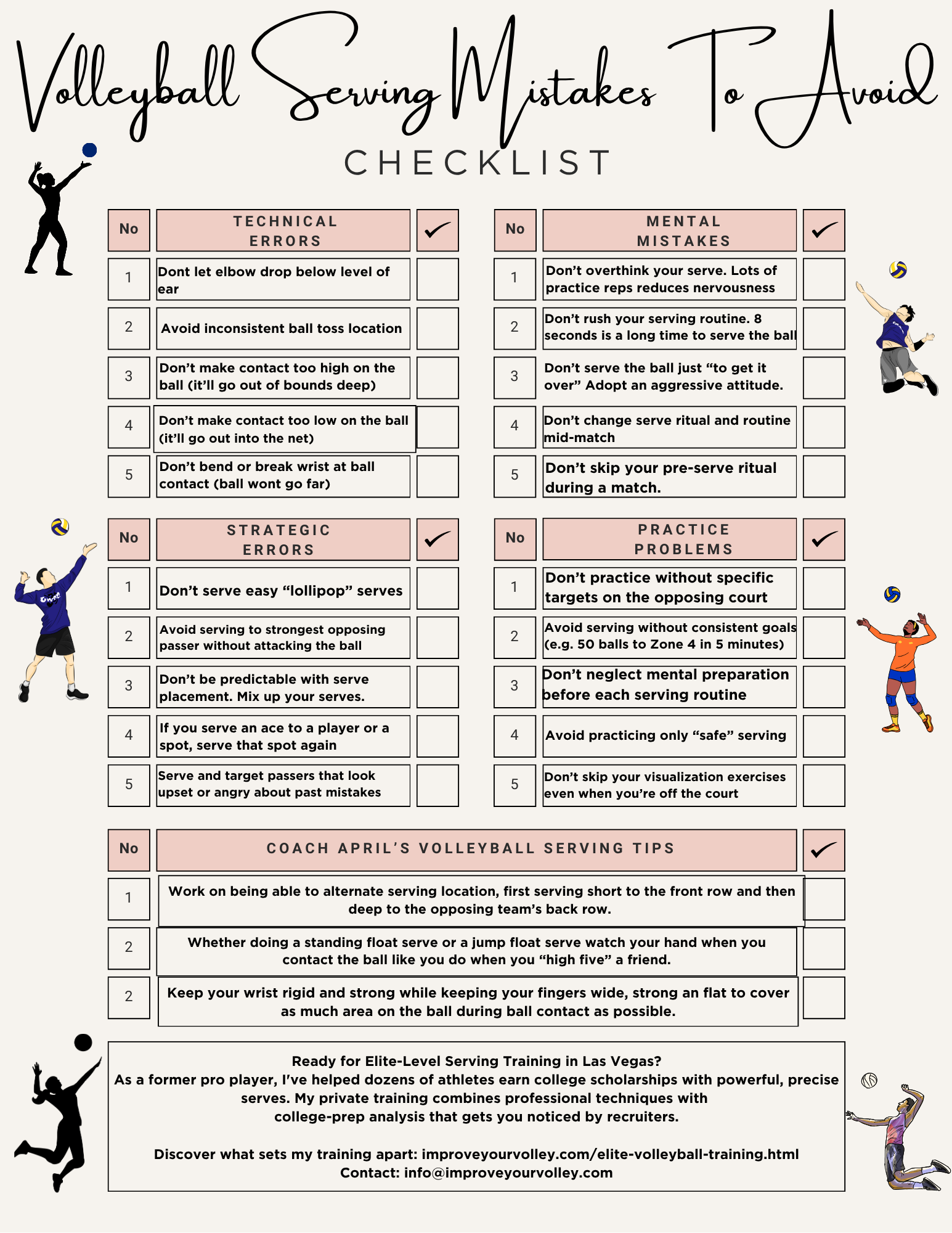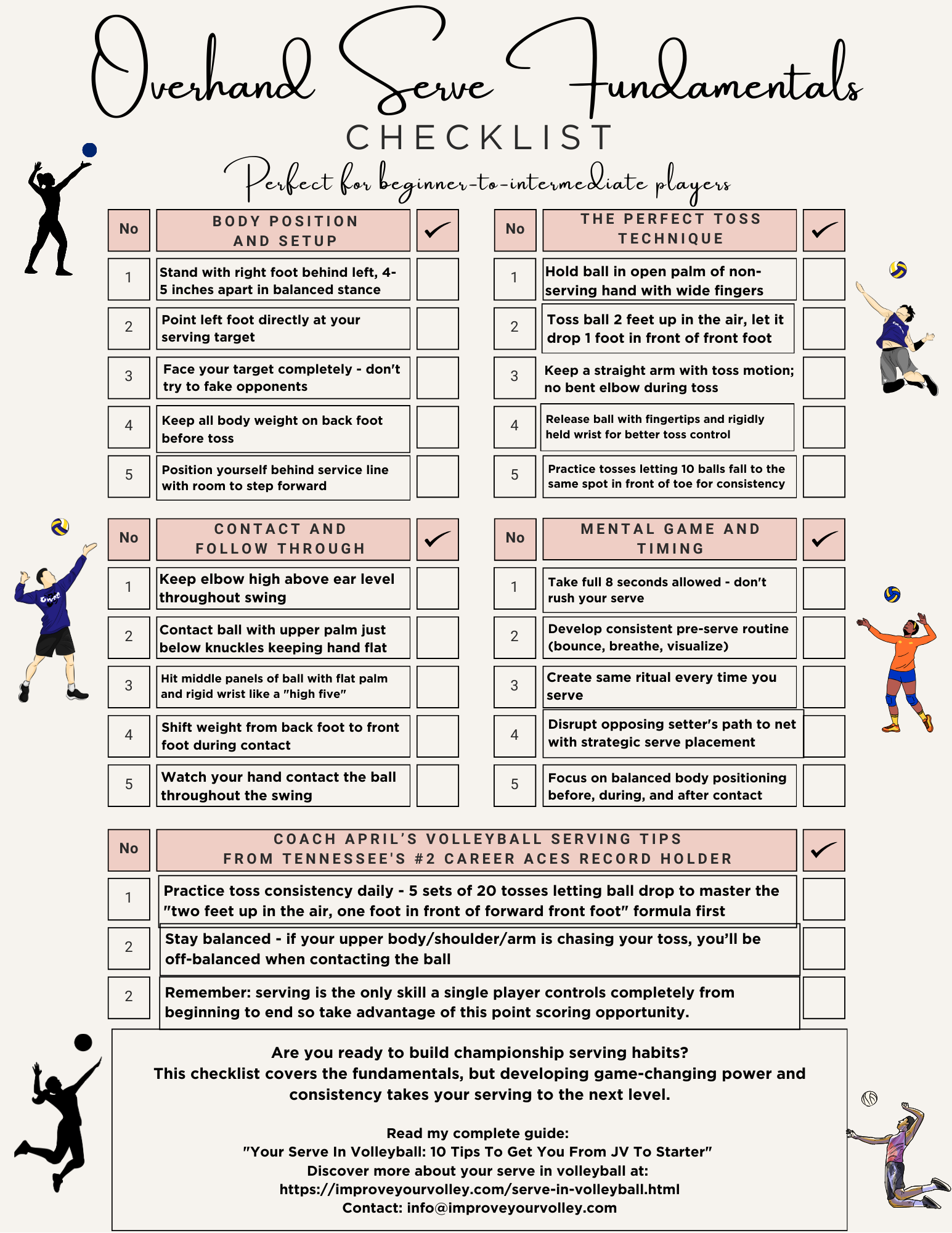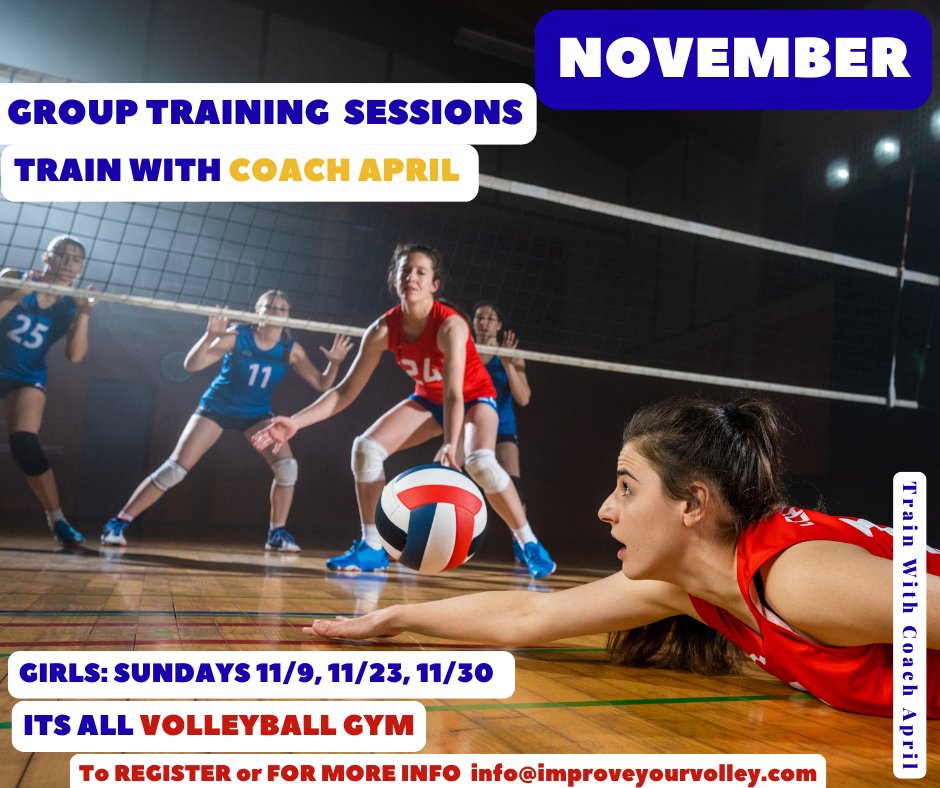- Improve Your Volleyball with Coach April
- Learn How To Coach Girls Volleyball
- Jump Float Serve in Volleyball
Quickly Elevate Your Game With A Deadly Jump Float Serve in Volleyball
In this simple guide, I teach you how to improve your jump float serve in volleyball by measuring your steps, create a serving ritual and how to fix your toss.
Jump Float Volleyball Serve Checklist - $7
|
This step-by-step checklist reveals the approach timing, contact techniques, and landing mechanics that separate struggling servers from jump float specialists. |
Inside, discover how to execute proper 3-step and 4-step approaches that build momentum like an airplane on takeoff, master the slow-to-fast acceleration that maximizes your vertical jump, and perfect the "high five" ball contact that creates the devastating float effect opponents struggle to pass.
Advanced technique volleyball checklist with 4-step approach breakdown, "airplane takeoff" timing, ball contact precision creating unpredictable flight, and landing mechanics preventing injury.
Master the serve that dominates at higher competitive levels with body-part-specific positioning only elite experience can teach.
In this simple guide, I teach you how to improve your jump float serve in volleyball by measuring your steps, creating a serving ritual, and perfecting your toss.
When done correctly, the jump float serve in volleyball is difficult for opponents to return.
The jump float serve in volleyball is a powerful way you can score an ace, a direct point by yourself, without the help of any other teammate with a serve that floats, dips and bobs after you contact it in the air as it makes its way over the net making it difficult to pass by the opposing team.
How valuable does this make you to your team?
When done correctly the jump float serve is difficult for them to return.
I will guide you through the steps needed to develop a powerful jump floater from
- setting up in the right position,
- to measuring your steps,
- to accelerating your approach from slow to fast
- to developing a consistent toss
- to mastering the perfect swing.
Creating a Serving Ritual for Your Jump Float Serve in Volleyball
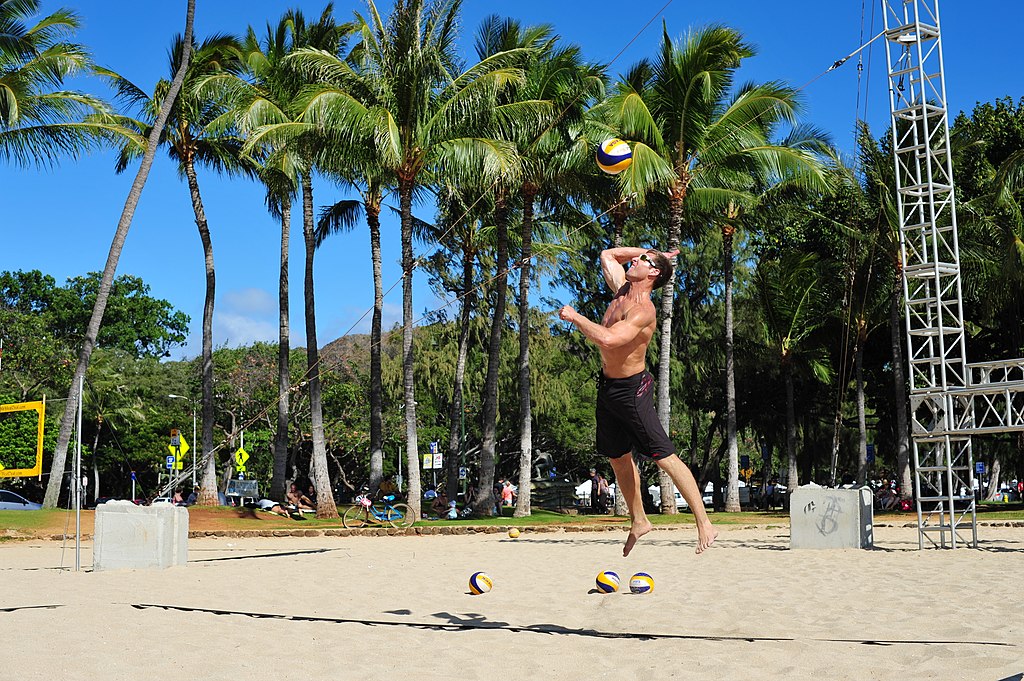
Chris Hunkeler from Carlsbad, California, USA, CC BY-SA 2.0, via Wikimedia Commons
Before starting your jump float serve, most players create a serving ritual before they do each serve.
A serving ritual is a way to "get settled" and get focused on the serve you're about to do next.
Measuring Your Steps for the Jump Float Serve in Volleyball
Addi works on her jump float serve toss consistency while aiming for a deep line serve to Zone 5.
They pause and stand with their heels on the service line with their back to the net before walking back to where they want to begin their serve, while taking a very precise number of steps, the same number of steps they plan to use during their serving approach.
Doing this ritual does two things.
It helps players measure out the correct steps and the distance each step is going to be so they get set up before the serve in the correct distance they need to be from the service line so they don't step on the line before they launch themselves in the air to jump.
Once you've turned around to face the net, you'll be standing facing the net about four steps away from the service line with your non-dominant foot slightly forward slightly in front of the foot you're going to use to take your first step in your serving approach.
Jump Float Serve in Volleyball
How do you aim a volleyball serve?
Face your target
Face your target.
When you are preparing to jump float serve in volleyball the float serve, you want to show everybody in the gym where you intend to serve the ball.
Pointing your body in one direction and then serving to another area on the court rarely “fakes out” the players in serve receive.
Award-winning Cal Poly SLO outside hitter, two-time Nevada state Gatorade Player of the Year, three-time Nevada state champion for Bishop Gorman and three-year private training client of mine, Tommi Stockham works on her float serve in one of our volleyball training sessions.
You will always be off-balance, and this will increase your chances of
- serving out
- making a bad contact with the ball or
- into the net
Be sure that your
- lower body---hips and waist along with your
- upper body---chest, shoulders and arms
are all facing your intended target once
- you've started and once
- you've finished
your serving action.
Ready to take your serving to the next level?
I help goal-oriented players who struggle with float serve consistency master next-level technique without endless frustration through personalized training that makes your float serve a reliable point-scorer for recruitment videos.
My private training sessions are specifically designed for college-bound athletes who refuse to settle for "good enough" serving.
Limited spots available for serious players only.
Serving Tips For Volleyball-
It's critical when you proceed through all of the serving steps, that you toss the ball the same way every time you serve.
Let that passer know that you are serving them.
Trust me, let that passer think about what kinds of trouble your serve is about to cause them.
Perfecting Your Toss for the Jump Float Serve in Volleyball
Your serving arm should be extended towards the ceiling with the palm facing the opposite wall while keeping your elbow close to your ear, so your arms form the shape of an L.
Addi performs the jump float serve in volleyball during semi private training lessons focusing on a consistent toss
To deliver a consistent toss, toss the ball with an open hand, keeping your tossing arm straight and your elbow locked. Guide the ball with your open palm 4-5 feet above your head and in front of you before or while you take your first step ...
Click to Download Your Consistent Toss Mastery Checklist pdf:
🎯Consistent Toss Mastery Guide - $7
Are inconsistent tosses sabotaging your serves and forcing you to chase the ball? Why fight your toss when you could master the foundation of every great serve?
Ideally the ball should travel straight up and down in front of your serving arm that will be contacting the ball.
It takes a lot of practice reps to get your toss right where you need it every time so be sure to do tons of tossing reps in volleyball practice.
Players are given a specific amount of time to serve a pre-determined number of balls to the target area formed by the chairs. hitting the middle of the chairs is rewarded more than just hitting the chairs in this case but coaches can come up with their own rules in irder to make this a tougher or easier drill.
Once the toss reaches its highest point then you complete your last two steps of your three step or four step approach while rotating hip and shoulder which brings the serving arm and hand to the ball, contacting the middle panels of the ball with the middle of your hand.
DOWNLOAD
YOUR
VOLLEYBALL SERVING MISTAKES
CHECKLIST
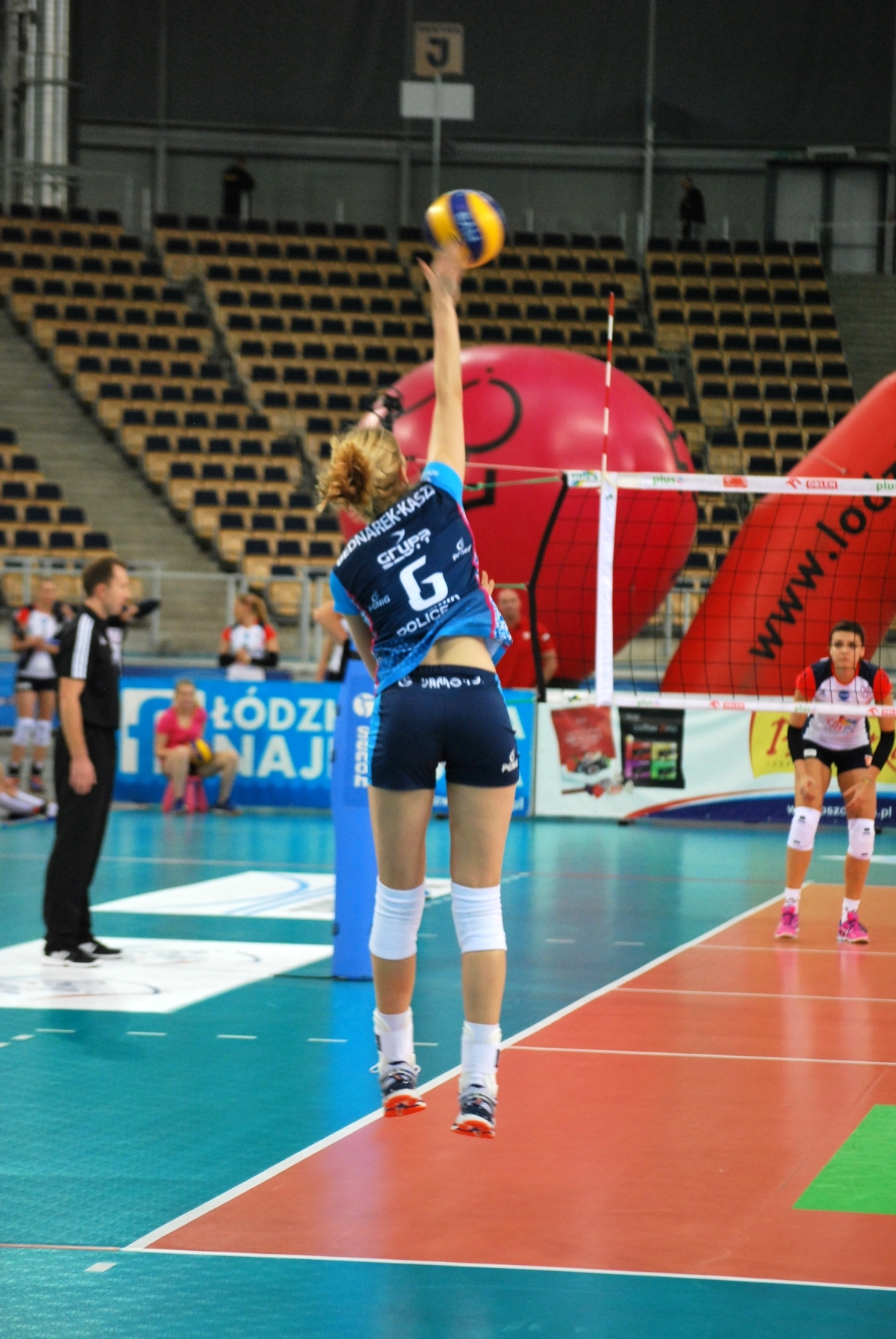 Bench Or Starter? 5 Volleyball Serving Mistakes Costing You Play Time
(Agnieszka jump float serve height by zorro2212)
Bench Or Starter? 5 Volleyball Serving Mistakes Costing You Play Time
(Agnieszka jump float serve height by zorro2212) ✓ Fix errors that keep you on the bench
✓ Practice efficiently with targeted solutions
✓ Track progress with professional checkpoints
✓ Access instantly—print or keep on device
✓ One-page format for quick reference
Click to Download Your Volleyball Serving Zones Checklist pdf:
🎯Volleyball Serving Zones Mastery Guide - $7
Why serve to their strengths when you could be exploiting their weaknesses?
Stop Serving Easy Balls—Start Exploiting Every Weakness on the Court
Click to Download Your Consistent Toss Mastery Checklist pdf:
🎯Consistent Toss Mastery Guide - $7
Are inconsistent tosses sabotaging your serves and forcing you to chase the ball? Why fight your toss when you could master the foundation of every great serve?
Mastering Your Approach for the Jump Float Serve in Volleyball
My College Breakfast Club training group working on jump float serve skills specifically hand to ball and toss consistency.
The jump float serve volleyball approach is where you build the momentum like a plane going down the runway that creates the power you need to generate to jump high in the air and create the pace needed to get the ball quickly over the net.
The approach is where you build the momentum like a plane going down the runway that creates the power you need to generate to jump high in the air and create the pace needed to get the ball quickly over the net.
Like your spike approach your first step or first two steps if you have a four step spike approach are slower smaller steps then the last two steps are your largest and most aggressive.
The last two steps are your most aggressive – a big step with your left foot, followed by a quick right-left-step if you're right handed and the opposite if you're a lefty.
I like to tell my clients that they want to treat the floor like a trampoline...and really attack the last two steps aggressively in order to launch themselves higher in the air.
Click to Download Your Pre Serving Ritual Mastery Checklist pdf:
🎯Volleyball Pre Serving Ritual Guide - $7
Transform Your Serve from Weak to Weapon
Stop letting pressure situations destroy your serves?
You'll Get
- ✓3-bounce physical preparation setup system
- ✓Mental routine for target pre-selection and visualization
- ✓Technical execution checklist for automatic consistency
- ✓Proven tips for bulletproof toss consistency
- ✓Pressure-proof strategies that eliminate serving errors
Click to Download Your Parent's Volleyball Serving Guide Help Your Player Develop Championship Serves (Even If You've Never Played) Checklist pdf:
🎯Parent's Volleyball Serving Guide Help Your Player Develop Championship Serves Guide - $7
You'll Get:
✓Learn exactly what to look for in your player's serving form so you can provide meaningful feedback.
✓Discover how to provide encouragement that actually improves performance and mental toughness.
✓Know exactly what to ask coaches to show you're engaged and help your player develop properly.
✓Simple, effective drills that don't require a gym or expensive equipment.
✓Understand the language coaches use so you can better support your player's development.
✓Help your player develop the psychological aspects of serving that many coaches don't have time to address.
The Jump Float Serve vs The Top Spin Serve in Volleyball
Unlike the top spin serve, where you contact the ball with arm follow through and bent wrist.... for the jump float serve you keep your wrist rigid and hand flat and straight on contact which creates a lot of float and unpredictable movement making the ball dip and float in the air with a lot of pace when it crosses the court and over the net making this type of serve very difficult to pass by players in serve receive.
The overhand jump serve volleyball technique adds more speed and momentum to the ball than a standing serve making it more challenging for the receivers to read and control.
Jump Float Serve in Volleyball
Ella Serves An Ace Between The Left Back and Middle Back Passers
Practice Makes Perfect
Finally, remember that everyone has a different style and rhythm. Pay attention to what works best for you and adapt the steps as necessary. With practice, dedication, and persistence, you will not only increase your serving power but also become a more valuable player to your team.
Jump Float Serve in Volleyball Toni with the float serve during Happy Hour Class Training
Be sure that your
- lower body---hips and waist along with your
- upper body---chest, shoulders and arms
are all facing your intended target once
- you've started and once
- you've finished
your serving action
Mastering the jump float serve in volleyball requires a focus on creating a serving ritual, measuring your steps, perfecting your toss, and mastering your approach.
Ready to Conquer Your Serving Skills Completely?
This article covered a number of tips for the jump float serve in volleyball, but if you want a complete systematic approach to serving excellence, check out:
🎯 FREE: 5 Essential Serving Tips Checklist
Perfect for beginners learning proper technique:
- Perfect stance positioning
- The "Two Up, One Forward" toss formula
- Mental approach techniques
- Plus 2 more essential tips
🏆 COMPLETE SYSTEM: 9 Serving Checklists
Ready to go from beginner to elite server?
Get the complete system:
- 180+ detailed checkpoints Foundation → Development
- Advanced progression
- Jump float serve mastery
- Tactical serving strategies
- Ace-scoring systems
📚 MORE SERVING RESOURCES:
Explore all my serving articles:
Read the Essential Serving Tips guide
Let me help you take your serving to the next level.
I help goal-oriented players who struggle with jump float serve consistency master next-level technique without endless frustration using personalized training that makes your float serve a reliable point-scorer documentable in your highlight and recruitment videos.
My private training sessions are specifically designed for college-bound athletes who refuse to settle for "good enough" serving.
Limited spots available for serious players only.
Do You Follow Me on Pinterest?
Follow me on Pinterest Volleybragswag to improve your game even faster!
I share alot of individual, partner and easy-to-do volleyball serving drills we do in class with my followers.
Many of these volleyball practice drills you can do at home by yourself or try at your next practice with your teammates.
If you're a B team or JV player trying to make varsity next year...your goal should be to complete 1000 reps a day of at least three of the basic skills on your own...volleyball passing, serving and setting should be at the top of the list.
Jump Float Serve in Volleyball
Where Do You Go From Here?
Where do you need to go now? Here are two options:
- Learn more about Volleyball Training by exploring the Related Links below.
- Follow the suggested reading on our Sitemap page Learning How To Play (Sitemap)
If your athlete struggles with consistent serve receive, gets subbed out, or is overlooked for playing time—this is the fix you’ve been looking for.

Struggling with passing consistency?
I help talented passers tired of getting pulled from games because of inconsistent serve receive skills BUILD passing confidence without expensive private lessons using the same 3-step system that's helped dozens of my athletes get recruited.
Download my eBook for $17.99 and start building the passing confidence that keeps you on the court—and gets you seen by college coaches.
From Lady Vol to Legend: Coach April Produces Powerful Passionate Players...is that you?
What Are You Looking For?
Click to Download Your Pre Serving Ritual Mastery Checklist pdf:
🎯Volleyball Pre Serving Ritual Guide -
Players! Learn How To Transform Your Serve from Weak to Weapon
Click to Download Your Parent's Volleyball Serving Checklist pdf
🎯Parent's Volleyball Serving Checklist Guide
Parents! Help Your Player Develop Championship Serves (Even If You've Never Played)

Hi there!
Thanks for stopping by. Hope you learned something today that will help you reach your volleyball goals.
Be sure to subscribe to my email newsletter so you can learn more each week!
Stay strong! Stay motivated!
-Coach April

SUSCRIBE to my email newsletter below!
 Click to learn more about the weekly volleyball classes and clinics or email info@imrpoveyourvolley.com for information
Click to learn more about the weekly volleyball classes and clinics or email info@imrpoveyourvolley.com for informationCongratulations to my seven Boys-18s Vegas Volley club players who played in two state championship finals yesterday, the 3A and 5A State champinship finals at Sunrise Mountain High School.
TOURNAMENT CHAMPIONS!
A-1 Vegas Volley VBC
In It To Win It Tournament
May 2 - 4, 2025 Tournament
Gold Medalists
18s Premier Division
Vegas Volleyball's Unsung Heroes: Celebrating Moms with Peace Love Volleyball Shirts
Ready to energize your volleyball mom journey?
Subscribe to my 'Producing Powerful Passionate Peaceful Players' email list above on ImproveYourVolley.com.
You'll receive energy-boosting tips, exclusive insights from me, Coach April Chapple on maintaining momentum in volleyball.
Let's power up the Vegas volleyball scene together!
Recent Articles
-
3 Exercises To Improve Spike Skills By Hitting With A Faster Armswing
Jan 06, 26 01:13 AM
These 3 volleyball exercises to improve spike skills by hitting more balls in the court with a quick armswing and aggressive spike approach to beat blockers. -
Your Serve in Volleyball: 10 Tips To Get You From Bench to Starter
Jan 02, 26 03:41 PM
I hold Tennessee's #2 career aces record (244 aces). Last month I coached 7 players to state finals. These 10 serving tips separate legends from bench players. -
Overhand Jump Serve Volleyball Tips To Score Many More Points and Aces
Jan 02, 26 03:14 PM
My "Coach April Overhand Jump Serve Volleyball Tips" designed to help you increase your serving accuracy, power and the ability to serve more aces in volleyball.
